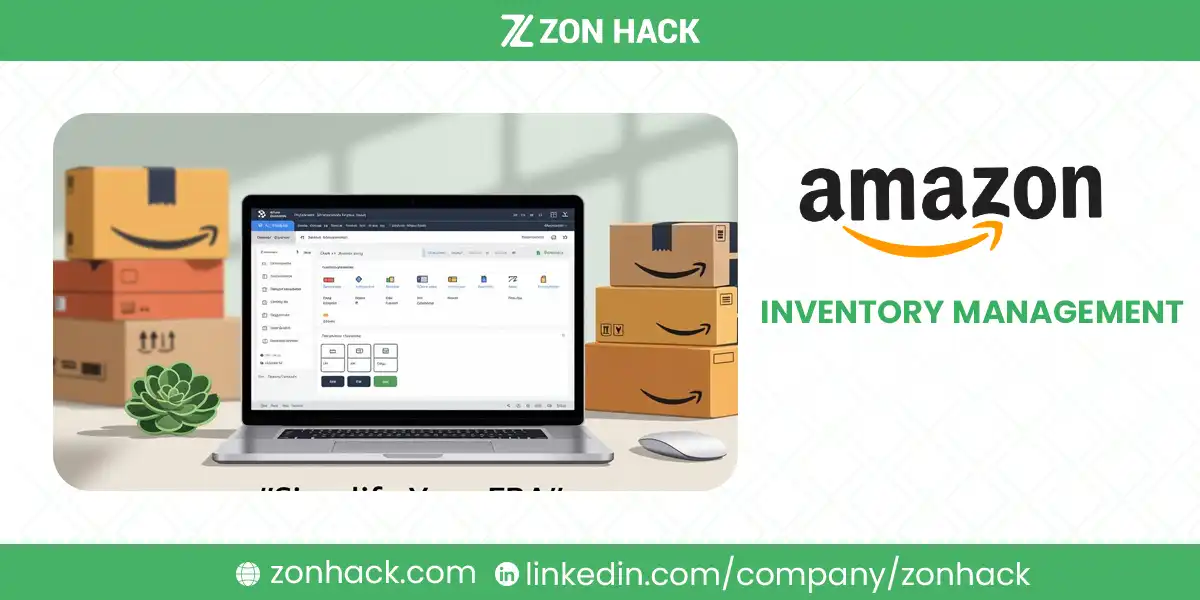Mastering Stock Control, Boosting Profits, and Avoiding Hidden Costs with ZonHack
Managing inventory on Amazon isn’t just about knowing how many units you have in stock. It’s about strategy. It’s about timing. And most importantly—it’s about profitability.
Behind every successful FBA business lies a well-oiled inventory system. Forecasting, restocking, storage cost management, fulfillment optimization—it all plays a role. Get it right, and you’ll scale faster, sell more, and pay less in fees. Get it wrong, and you’ll be stuck in a loop of overstock, lost Buy Box rankings, or stockouts when you need inventory most.
At ZonHack, we’ve helped over 500+ Amazon sellers fine-tune their inventory workflows. Whether you’re struggling with IPI score drops, drowning in excess units, or trying to prepare for Q4, this guide will give you the clarity you need—and the systems to act on it.
Why Smart Inventory Management is Critical for Amazon Sellers
Most FBA sellers learn this the hard way:
Inventory mismanagement can quietly destroy your business.
If you overstock, you’re bleeding money in monthly and aged storage fees. If you run out of stock, you lose sales velocity, drop in rankings, and sometimes lose your Buy Box altogether.
But it’s not just about what’s happening today. Amazon watches your every move. They reward sellers who keep their inventory lean, fast-moving, and accurate. That’s why Inventory Performance Index (IPI) matters so much. It’s not just a score—it dictates:
- How much stock Amazon allows you to send in
- Whether you qualify for unlimited storage
- If you get priority warehouse placement during peak seasons
Here’s the simple truth:
Inventory management is the engine behind profitability, IPI scores, and customer satisfaction.
That’s why ZonHack doesn’t just look at your numbers—we audit your entire inventory system. From sales velocity to supplier lead times, we tailor stock control strategies that fit your product type, seasonality curve, and business goals.
Core Metrics Amazon Sellers Must Monitor
Let’s break down the key numbers Amazon uses to measure your inventory health—and how they affect your bottom line.
1. Inventory Performance Index (IPI)
The IPI score ranges from 0 to 1000.
Amazon considers anything below 400 a warning sign. If you’re under that threshold, your storage space will be restricted.
Four major factors influence your IPI:
- Excess Inventory %: High levels = inefficiency.
- Sell-Through Rate: How fast your inventory sells.
- Stranded Inventory: Unsellable stock stuck due to errors.
- FBA In-Stock Rate: How often your top sellers are available.
ZonHack runs monthly IPI audits and builds mitigation plans so sellers stay well above the danger zone—usually aiming for 600+.
2. Sell-Through Rate
This metric shows your sales speed over 90 days:
Formula: Units Sold (90 days) ÷ Avg Inventory on Hand
Amazon likes to see this number above 2.0, but it depends on your category. Low rates signal overstocking. High rates might mean you’re risking stockouts.
3. Weeks of Cover (WOC)
This metric answers the question: How long will my inventory last based on current sales?
Ideal target: 8 weeks
To calculate it, use:
(Inventory on Hand ÷ Average Weekly Sales)
Maintaining 6–10 weeks ensures you’re protected from supplier delays but not hoarding slow-moving stock.
4. Inventory Turnover Rate
This tells you how efficiently you’re moving product relative to what it costs:
Formula: COGS ÷ Average Inventory Value
Higher turnover = leaner inventory and better cash flow.
5. Stranded Inventory
These are units sitting in Amazon warehouses but not available for purchase. Causes include:
- Listing errors
- ASIN policy violations
- Delisting by Amazon
Stranded inventory drags your IPI down, clogs up storage, and racks up fees.
6. FBA In-Stock Rate
While it doesn’t directly affect IPI, it affects your visibility.
If your top-selling ASINs go out of stock, Amazon throttles your listing, lowers ad performance, and buries you in search.
Understanding Amazon Fulfillment Models & Their Inventory Impact
Inventory strategy changes based on how you fulfill your orders. Here’s how each model affects your stock control.
1. Fulfillment by Amazon (FBA)
Amazon stores, ships, and handles customer service. It’s convenient, but comes with rules.
Challenges include:
- Monthly and long-term storage fees
- Labeling compliance (wrong labels = delays)
- Delayed visibility into aging stock
ZonHack helps FBA sellers with real-time restocking alerts, listing syncs, and liquidation triggers to prevent excess fees.
2. Fulfillment by Merchant (FBM)
Here, you store and ship your own products—or use a 3PL.
Risks:
- Overselling if inventory isn’t synced
- Manual errors or delayed delivery
- No Prime badge = lower conversion rates
FBM gives more control but requires airtight inventory syncing, especially across channels like Shopify or TikTok Shop.
3. Seller Fulfilled Prime (SFP)
You ship the orders but still earn the Prime badge.
Sounds perfect? Not quite.
Amazon has strict performance requirements:
- 2-day delivery nationwide
- Real-time inventory syncing
- High accuracy in shipments and returns
ZonHack helps sellers evaluate SFP readiness and sync systems to meet Amazon’s rigid SLAs.
Most Common Amazon Inventory Mistakes Sellers Make
Even experienced sellers fall into these traps:
1. Overstocking Out of Fear
Many sellers order in bulk to avoid stockouts. But overstocking chokes cash flow, kills sell-through rate, and tanks IPI.
2. Poor Forecasting
Guesswork doesn’t cut it anymore. Misjudging demand—especially around Q4—can lead to dead inventory or lost momentum.
3. Ignoring Seasonality
Q4 sales spikes are obvious. But what about Q1 drops? Or Prime Day? Failing to plan for seasonal cycles causes stock imbalance.
4. Returns Blindspot
High returns mean higher unsellable stock. Many sellers forget to track reasons or estimate how many units won’t be resellable.
5. Weak Supplier Coordination
If your supplier has a 45-day lead time, your reorder window needs to reflect that. If you underestimate, you’ll stock out before the next shipment lands.
6. Selling on Multiple Channels Without Sync
Expanding to Walmart, TikTok Shop, or eBay? That’s great. But if inventory isn’t synced, overselling becomes a risk. Worse: canceled orders lead to negative reviews.
7. Listings That Don’t Sell
Poor copy, bad images, and weak keywords slow sell-through. Even if you manage inventory well, you’ll still overstock if your listing isn’t converting.
Handling Excess Inventory: Liquidation & Recovery Tactics
Even the most seasoned Amazon sellers deal with excess inventory. Sometimes it’s a forecasting misfire. Other times, a product just doesn’t gain traction.
But one thing is clear—letting it sit in FBA is the most expensive option.
Amazon charges monthly storage fees and imposes Aged Inventory Surcharges once stock passes 181 days. If you’re not proactive, that slow-moving inventory eats into your margins fast.
Liquidation Options Worth Considering
1. Amazon Liquidation Program
Amazon allows you to liquidate unsold inventory and recover 5% to 10% of the item’s average selling price. It’s a quick exit, though not the most profitable.
2. Bundle with Best-Sellers
Pair slow-moving SKUs with fast-selling ones. It can increase average order value and clear backlogged items without slashing prices.
3. Lightning Deals or Deep Discounts
Amazon Lightning Deals, 7-day deals, or aggressive couponing can drive temporary demand spikes.
4. Wholesale to Other Sellers or Competitors
Yes, it happens. Offloading to another seller who has demand (or a better listing) can be a viable cash-recovery route.
5. Contests or Giveaways
If branding is your long game, consider running contests to distribute excess stock. While you don’t make immediate revenue, you expand reach and boost your review velocity.
“Inventory not turning over is not just a storage problem—it’s a cash flow problem. The longer it sits, the more it costs.” – ZonHack Inventory Team
Alternatives to Liquidation
Some sellers find success cross-listing excess inventory on platforms like:
- eBay
- Etsy
- TikTok Shop
With ZonHack’s multi-channel sync setup, you can distribute that inventory without worrying about overselling or fulfillment confusion.
Another option is to run targeted PPC campaigns to revive traffic to those listings. ZonHack’s campaign strategy often revives 15–25% of what sellers were about to liquidate.
Short-term strategies like Buy One Get One Free (BOGO), flash discounts, or inventory-based promos can also move dead stock—especially if paired with urgency tactics like countdown timers or scarcity triggers.
Recommended Inventory Management Tools
You can’t optimize what you can’t track. Here’s a breakdown of the tools sellers use—and what we recommend based on seller size and complexity.
Manual Tools (for Small Sellers or Newbies)
Google Sheets or Excel
Easy to set up but not scalable. Risk of human error increases with volume.
Good for basic tracking, but not for:
- Forecasting
- Multi-ASIN management
- Automation
Smart Inventory Software
| Tool | Best For | Highlights |
| SoStocked | FBA-focused sellers | Forecasting, order tracking, bundles |
| SellerCloud | Multi-channel pros | Deep integration with eBay, Walmart |
| Zoho Inventory | SMBs | Low cost, sync with Shopify & Amazon |
| Veeqo (by Amazon) | Amazon-first brands | Real-time syncing, barcode scanner app |
| Cin7 | Medium to large brands | ERP-level depth, smart automation |
ZonHack helps configure and integrate these tools into your existing workflow. We also manage API connections to ERPs or third-party systems.
ERP & OMS Solutions
For brands scaling fast, Enterprise Resource Planning (ERP) or Order Management Systems (OMS) centralize inventory, accounting, and fulfillment.
If you’re using Shopify and Amazon together, this is where inventory mismatches can cause oversells—or worse, account flags. ZonHack builds custom ERP connections to clean up this chaos.
Barcode & Scanning Tools
Pick-pack errors can ruin your margins. Implement scanners and labeling systems early on if you manage your own warehouse or 3PL. ZonHack recommends this for sellers handling 100+ orders/day via FBM or SFP.
Virtual Assistants (VAs)
ZonHack provides Amazon-trained VAs for:
- Shipment creation
- Inventory reconciliation
- Listing edits
- Restock alerts
They operate within Seller Central and your tools, ensuring consistency across your systems.
FBA Shipment Reconciliation: Don’t Leave Money on the Table
Many sellers skip this step—and leave thousands of dollars unrecovered each year.
When you send a shipment to Amazon, errors happen:
- Units go missing
- Items get damaged en route
- Amazon miscounts or misplaces inventory
Here’s what you must do:
1. Go to: Seller Central → Manage FBA Shipments
2. Check: Closed shipments within the last 45 days
3. Reconcile: If units were short or damaged, request reimbursement
Note: For high-value items or shipments older than 60 days, Amazon may ask for proof of purchase or invoices.
ZonHack includes monthly FBA audits in our inventory service plans. We’ve recovered $2,000–$15,000 per seller annually, depending on volume.
Advanced Strategy: Continuous Inventory Optimization
The best sellers don’t just react—they refine. Continuous inventory optimization means you’re constantly:
- Revisiting your forecasts
- Re-evaluating supplier timelines
- Segmenting SKUs based on performance
Start with manual forecasting in your early phase, but build systems for automation as you scale.
ZonHack creates dynamic forecasting models that adjust based on:
- Your PPC spend
- Current keyword trends
- ASIN-level competitor movement
- Seasonality shifts (Prime Day, Q4, etc.)
We also help segment your inventory:
| Segment | Strategy |
| Fast movers | Replenish frequently, use JIT |
| Seasonal SKUs | Forecast early, bulk order pre-season |
| Dead stock | Push with discounts or bundles |
| Launch-phase | Use conservative estimates, test demand |
ZonHack Makes Amazon Inventory Scalable
If you’ve made it this far, you already know this:
Inventory is not just logistics—it’s strategy.
Poor inventory decisions cost money. Great inventory systems make money. The difference lies in forecasting, syncing, and acting ahead of time.
At ZonHack, we don’t just plug in tools—we design a strategy around your catalog, your goals, and your growth plans.
We’ve helped:
- New FBA sellers fix IPI scores and unlock restock limits
- 7-figure brands clean up overstock and reclaim cash flow
- Multi-channel merchants sync stock across Amazon, Shopify, Walmart, and TikTok Shop
Need help with Amazon inventory management?
Let ZonHack audit your stock flow and build a scalable system tailored to your business.




